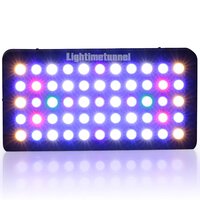Has anyone tried growing plants by using full spectrum lights?
Yes and they are aestheticaly crap.. This is a concept from the led industry using some logics behind the design, not aimed towards aesthetics but towards enrgy input/uotput sufficiency.

Full spectrum in the name is just a marketing, it aint fuller spectrum than a normal white light when it comes to growing plants.
Scientificaly it is prooven we can grow plants under solely red and blue light within a certain wavelenght. What yet is unknown if or what the plant does with the rest of the spectrum.
So when the LED industry came involved with growing plants they considered output sufficiency devided over a x amount surface area with an x amount of led units x output power x power consumption. Since leds weren't particularly strong and you need quite a lot units to perform something usefull, than using the majority blue and red LEDS gave more sufficient usefull PAR regarding plant growth in comparison with the same sum in only white light leds over the same surface. In regard that the plant after all only needs Red and Blue.. Easteticaly it's a dissaster, but regarding plant growth it was for the time beeing more sufficient.
This only was of importance if you are growing e.g. a tomato, you want a fat tomato in the first place and do not care about it looking good during the process of growing.
So these so called full spectrum setups are originaly only aimed towards uotput power v. concumption v. usefull PAR. They were absolutely not beter than any other equivalent white light source with same PAR output.
When looking into an aquarium looks is a different story.. In the first place you want it to look good. And is does look best under a natural as possible white light source. Still this is a mater of taste in how your eyes perceive white light and how the plant reflects it, you can choose between 2000K and 10000K or a mixture of these. In general consensus it is said 6500K is natural white and likely the best color to grow plants and looking good at the same time.

But in the end they grow under any white light you give them.
These light setups are actualy something old fashion from the LED era, even tho they are only few years on the market. LED industry rockets in development and progresses still with in months. The newest generation much beter performing full spectrum grow LED units all give white light by now.. Since day light spectrum still is the best and realy full spectrum.






